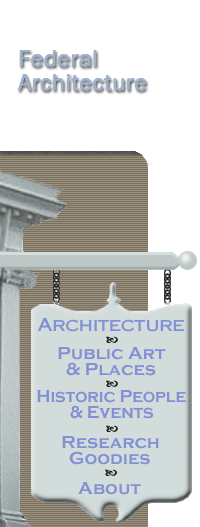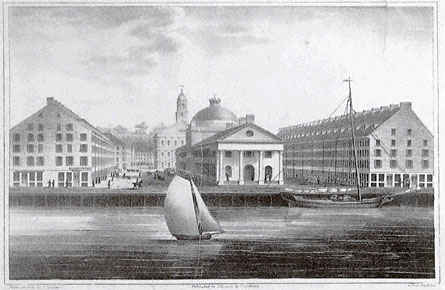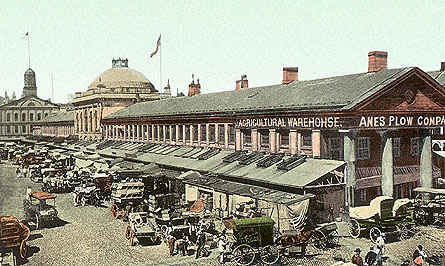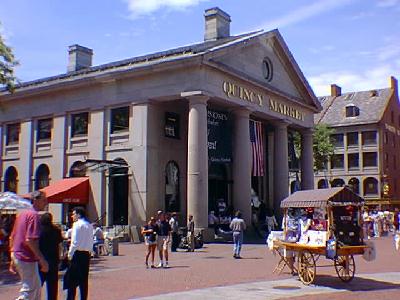
| 
Quincy Market
Alexander Parris, 1824 -
1826
 Quincy
Market is such a strong sign of revitalization in Boston, that its earlier
significance is easily eclipsed. Quincy
Market is such a strong sign of revitalization in Boston, that its earlier
significance is easily eclipsed.
This was the first major project initiated after Boston became a city. It
established the city as able to structure its own development, and the mayor's
office as a position for coordinating city planning and development.
After several false starts, Boston finally incorporated as a city in 1822,
and faced the challenges of growth into a metropolis.
Once again food distribution was among the most pressing problems for the
new city. While Faneuil
Hall (pictured here behind Quincy Market) had proven to be a useful,
its 14,000 square feet of space was no longer nearly adequate to support
the City's nearly 50,000 residents. The response required was larger than
any one individual could provide, and would have a sweeping impact on the
city.
 In
a single sweep, Quincy Market enhanced city-life and commerce, caused the
redesign and addition of six new streets, and established the City Docks
in still deeper waters. In
a single sweep, Quincy Market enhanced city-life and commerce, caused the
redesign and addition of six new streets, and established the City Docks
in still deeper waters.
In the next fifty years Boston would grow from around 50,000 to over 250,000
citizens. The market's lesson, that the City could facilitate opportunities
for business and civic growth, would lead Boston to remake its self in even
more bold ways.
 Built
on the ocean's edge, Quincy Market's Ionic porticos with monolithic columns
on each end, would have made a strong impression to those approaching by
sea, or from the State House. The 535 foot long market concludes on both
ends with monolithic columns supporting pediments reminiscent of Greek temples. Built
on the ocean's edge, Quincy Market's Ionic porticos with monolithic columns
on each end, would have made a strong impression to those approaching by
sea, or from the State House. The 535 foot long market concludes on both
ends with monolithic columns supporting pediments reminiscent of Greek temples.
The entry to the building is further enunciated by semi-circular windows
above its large central doors. The white granite constitutes a structural
facade, which would be freestanding without the brickwork used to separate
merchant stalls inside.
The Market is visually rhythmical and symmetric, with a feeling of order
emanating from the street-like nature of the main promenade. The market
has a series of eight thin rectangular chimneys even distributed along the
length of the building. At its center is a muted copper dome which rises
above a small copper wall cornered with granite blocks.
Revitalization
Between 1976 and 1978 the Faneuil Hall Marketplace was restored, and repurposed
as a tourist destination and retail location surrounded by history. Architect
Benjamin Thompson and Associates secured the commitment of the City
and the financial commitment of the Rouse
Company which has gone on to replicate this success in other cities.
Contemporary additions to the building are complementary, but are visually
distinct, providing the visitor with an accurate idea of the market's original
form.
|
|
| INTRODUCING |
|
From the writers of iBoston.org |
|
|
|



